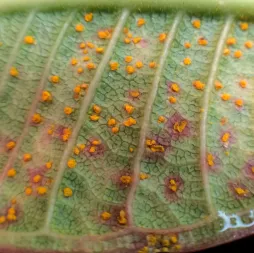Sempervivum tectorum, roof houseleek
Sempervivum tectorum grows in the mountains of southern and eastern Europe. It has been cultivated since Antiquity for its supposed magical powers. In the Middle Ages, it was planted on the roofs of houses to protect them from lightning strikes. While there is no evidence that the plant can withstand thunder and the wrath of Zeus, it can survive frost and temperatures down to -25°.
How to recognize the roof houseleek, Sempervivum tectorum?
Sempervivum tectorum is a succulent plant with a creeping habit. When in flower, it can reach 50 centimetres in height.
The rosette of leaves is 5 to 15 centimetres wide. It consists of lanceolate, glaucous-green blades with red apices and hairy margins. The rest of the leaf, fleshy and waxy, is hairless. The arrangement of the down distinguishes the roof houseleek from its cousins, spider's web houseleek and mountain Jewel.
In summer, bunches of pink flowers bloom at the top of a flowering spike covered in scales. But mountain houseleek blooms only once. It dies when the flowering period is over. Fortunately, it takes care to multiply before withering. Each year, it produces up to 30 new rosettes of leaves along its stolons.
Sempervivum tectorum is said to have medicinal and magical properties. From corns and insomnia to burns and impotence, rooftop houseleek is said to cure all ills. But it's best not to play the sorcerer's apprentice. The plant is said to contain substances that are toxic to animals if ingested.
Our maintenance tips
Rooftop houseleek are easy-living outdoor plants. All they need is a sunny spot and a well-draining substrate. They can flourish on a roof, in the crack of a low wall or in a rockery. You can also grow them in pots. There's just one rule: don't mix them with other species, which might take over.
Watering
Water only when the soil has completely dried out. Use room-temperature water with low calcium content, such as rainwater.
Water generously to allow the leaves to soak up the water. Make sure any excess water has drained away before replacing your Chimneyleaf. If necessary, remove any water that has accumulated in the saucer or planter.
Spray
Rooftop houseleek grow in arid regions and do not like humidity. No need to spray them.
Repotting
In spring, transfer your Sempervivum tectorum to a larger pot, so that it can continue to grow.
Obtain a pierced terracotta pot. Line the bottom with a layer of clay balls or gravel. This way, in the event of over-watering, your plant won't get its feet wet.
Add a mixture of garden soil (50%) and sand or pozzolan (50%). Plant your Chimneyleaf in the center. Tamp and water to remove air bubbles.
Prune
Remove dried leaf rosettes after flowering.
Plantation
Once the last spring frosts have passed, you can plant.
Choose a sunny, well-drained spot, such as the top of a slope. Loosen your soil by scratching it. If your soil is compact, add sand, crushed pozzolana or gravel to lighten it.
Dig a hole the size of the root ball and plant your Chimneyleaf. Space the different plants at least 20 cm apart to give the shoots room to develop. Don't plant other, larger varieties nearby. They may overshadow and take over the whole space.
Tamp and water to help the plant take root.
Cutting
Cutting is carried out during the strong growth phase, generally in spring and early summer.
After a few years, young shoots appear at the base. With a sharp knife, dig up one of these "babies", also removing its roots.
Obtain a perforated pot. Add a layer of clay balls or gravel to the bottom for drainage.
Mix equal parts garden soil and sand or crushed pozzolan. Plant roof Jewel in the center. Tamp gently and water generously to encourage rooting.
Disease / Threat
Information
| Family | Crassulaceae - Crassulaceae |
| Type | Joubarbe - Sempervivum |
| Species | Chimneyleaf - Sempervivum tectorum |
| Lifecycle | Perennial |
| Foliage | Evergreen |
| Exposures | |
| Substrats | |
| Planting methods |
Open ground In pots Planter |
| Categories | |
| Tags |
Beginner Flowery Increvable Rustic Toxic |
| Origins |
Eastern Europe Southern Europe |
| Hardiness (USDA) | 6a |
| Leaf color |
|
| Flower color |
|
Discover plants from the same family
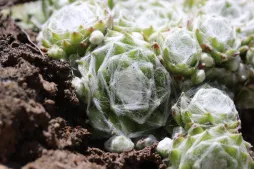
Spider's web houseleek
Discover
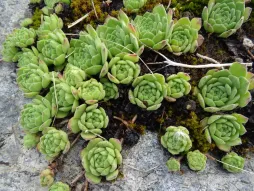
Mountain houseleek
Discover
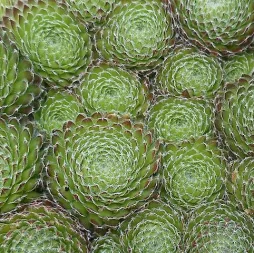
Ciliated houseleek
Discover
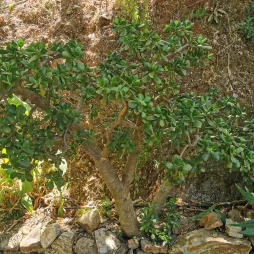
Jade tree
Discover












